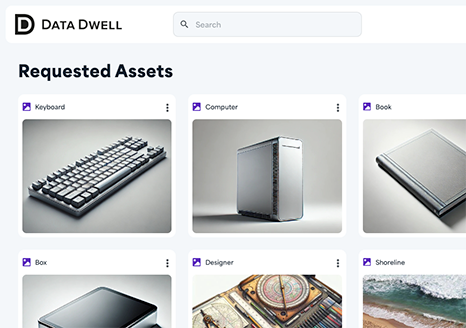Store, search and share all your assets, faster and easier than ever.
The single DAM platform that frees your content… and your time.
Book a demoThousands of hours saved for 100's of global brands
Multinational organizations in every sector use Data Dwell to simplify, streamline and save with their digital asset management


























Say goodbye to
content confusion
Data Dwell is designed to give you the control you need. Store your files efficiently. Search content easily. And share every asset effortlessly.
No more missing files. No more scattered folders. No more wasted time.

DAM that's efficient
Data Dwell puts you and your content first. Every workflow is built around a process that works for your team - from auto-tagging to custom categorization.
Custom tags and filters
Use smart metadata, auto-tagging functionality and a structure set-up to match the way your team works.

Instant file conversions
Get the files in the formats and sizes you need, at the click of a button - without the usual hassle or confusion.

DAM that's easy
Data Dwell makes storing, searching and sharing your content quick and easy. No complicated structures, no confusing setup.
Enhanced metadata
Find the exact file you need with AI search functionality across detailed, customizable metadata on every asset.

Unlimited portals & links
Create customizable portals to share files and folders internally and externally, all with one simple link.

DAM that's engaging
Data Dwell seamlessly connects your content with your customers, identifying buying signals and maximising engagement with every asset.
Digital sales room
Build your own branded portals to share the exact content you need with your prospects - fully editable in real-time.

Instant notifications
Unlock deeper content analytics and get instantly notified when your audience interacts with any of your assets.

DAM that's effective
Data Dwell is built around your requirements to give you the results you need - assets found immediately and time saved instantly.
Smart user permissions
Assign role-based user permissions to manage content access or editing, down to an individual file level.

Asset activity management
Monitor and report on all asset access, downloads and changes, controlling versions and managing outdated files.

Ready to try a DAM
that works for you?
Book a demoWhy Data Dwell?
As one of the most highly rated DAM platforms on trusted review sites, there are many reasons global brands choose us - and stay with us - from fast setup to on-demand support.




DAM that's quick
Spin up Data Dwell in days not weeks, with hands-on support through every step of the way - including file migration and uploads - from our expert team.
DAM that's personal
Feature request? Custom API? Not a problem. Our clients love the personal support they get to make their DAM their own.

What our clients say
Simplifying Digital Asset Management
“Data Dwell Digital Asset Management makes organizing and retrieving assets simple. The interface is user-friendly and intuitive. It helps improve workflow efficiency and collaboration. Overall, it provides a reliable solution for managing digital content.”
Blue Lagoon Iceland / Data Dwell
“The ease of uploading and organisation of the assets, and most of all the speed and ease of overview and viewing the assets without loosing time with uploading previews (which is extremely fast in Data Dwell) so finding an image (if database is organzed well) is very fast. I use it on daily basic, and it helps speed up the work a lot. when I needed the customer support, I recevied immediate answer.”
Working with Data Dwell on our MediaHub for almost 2 years now
“First of all, the relationship with Data Dwell's employees. - outstanding professionalism, knowledge, flexibility, and help throughout the whole process - from day one until today. It is of high importance to me to keep in contact closely and work on improvements, bugs, or any issues we face, which has been the case. Thank you! Moreover, having such a great working solution for all of our assets has been great, and the fact that it is so flexible and can be changed for our wishes, is fantastic!”
Your trusted Partner for Reliable DAM solution
“Data Dwell always there to help. Professional, stable and trusted partner for us. Always listen, digest and come back with realist solutions.”
Data Dwell is efficient solution for our data distribution needs!
“Data Dwell’s centralized platform makes it incredibly easy to organize, update, and distribute digital assets (like presentations, protocols, and marketing materials) across global teams and partners. The intuitive interface ensures quick adoption, while granular access controls keep sensitive data secure. Real-time updates and version tracking eliminate confusion, ensuring everyone accesses the latest files—saving time and reducing errors.”
Ready to try a DAM
that works for you?
Book a demoDiscover what Data Dwell can do for you
Get in touch with our team to book a demo, ask about a specific feature or see how our DAM can save your team time, money and effort overnight.